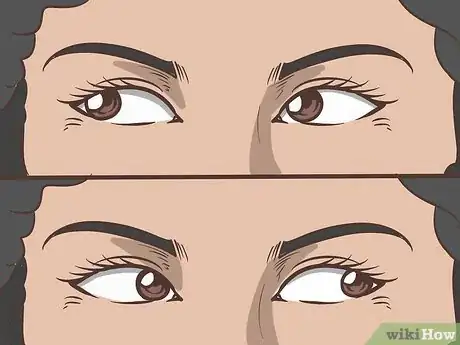This article was co-authored by wikiHow Staff. Our trained team of editors and researchers validate articles for accuracy and comprehensiveness. wikiHow's Content Management Team carefully monitors the work from our editorial staff to ensure that each article is backed by trusted research and meets our high quality standards.
This article has been viewed 904,006 times.
Learn more...
Wiggling your ears is a pretty rare skill due to the way humans have developed over time. Not everyone can do it, so to learn how, it’s important to first know what’s involved. With a better idea of what to expect, practicing how to do it is simply a matter of warming your whole face up and then concentrating on the muscles involved.
Steps
Facial Muscles
-
1Keep your expectations realistic. You’re probably not pinning all your hopes and dreams on the ability to wiggle your ears, but just in case you are, brace yourself. Accept the possibility that you may not be physically capable. So don’t beat yourself up if nothing happens! Blame your ancestors instead.[1]
- Wiggling your ears is what’s known as a “vestigial” trait. This means that, once upon a time, our ancestors were all able to do this quite easily. But since it doesn’t serve any real purpose, people just quit doing it, so over time humans lost the ability to do it so easily.
- There’s some debate about how many people are still able to do it. Some believe that only a small percent are capable, while others believe that more people than that can relearn how to do it with practice.
-
2Identify the muscles needed. To truly master wiggling your ears, concentrate on not one, but three different muscles: the auricularis anterior, posterior, and superior. Don’t worry about the fancy names, though. Just focus on what each muscles does.[2]
- The auricularis anterior lifts the ear both upward and toward your face.
- The auricularis posterior draws it toward the back of your head.
- The auricularis superiors only lifts it upward.
Advertisement -
3Practice other facial tricks first. Some people have found that learning to control other specific muscles in your face makes learning how to wiggle your ears easier. So if there’s another trick that you find easier to do, start off with that instead. Then, once you learn how to manipulate one small cluster of muscles, switch back to your ears. You could try learning how to:[3]
- Raise only one eyebrow.
- Roll or dart just one eye at a time.
- Flare your nostrils.
- Shrink and dilate your pupils.
Warmups
-
1Locate your ears’ muscles by flexing others. Expect the muscles in your face to affect other neighboring ones whenever they contract or expand. Use this to really feel how your ears move in relation to other facial features. Try to isolate the muscles in and around your ears as you do.
- As an experiment, raise your hand. Curl your fingers into a fist and squeeze. Most likely you’ll feel the muscles in your forearm tighten without you having to command them to.
-
2Dart your eyes from side to side. These may possibly have the strongest and most direct effect on your ears’ muscles. To see how, look to either side of you without turning your head or neck. Concentrate on your ears as you do. Chances are that you will feel one or both pull back.[4]
- You’ll probably look a little crazy, but go with it and just go nuts with your eyes. Look in all directions, roll them around, or anything else that comes to mind. Feel how each action might tug your ears forward or push them back.
-
3Move your brow muscles up and down. If you can raise one eyebrow at a time, do it. If not, raise both. Then furrow your brow like you’re really mad. Alternate between the two and vary speeds. Keep your focus on your ears and how their muscles respond.[5]
-
4Smile. Grin like you’re the Joker, nice and wide. Lift your cheeks as you do. As before, concentrate on what your ears do in response so you can isolate the muscles there.[6]
Moving Your Ears
-
1Experiment with moving all three muscles. Don’t worry about mastering any one motion just yet. For now, see if you can move them at all. Once you’ve warmed your face up and isolated where your ears’ muscles are grouped, flex them any which way you can. Alternate between trying to move them up, backward, and forward.[7]
-
2Focus on one muscle at first if needed. If you have instant control over all three muscles, good for you! But if you find that you have far more control over just one or two, focus on those for now. Continue flexing and relaxing each one to strengthen both that muscle and the ones connected to it.
-
3Move on to the others one by one. As you gain more and more control over the first muscle that you focused on, move on to whichever one feels the most responsive. Practice that by itself at first, and then start alternating between that and the one from before. Then, when both start feeling more natural, move on to the last muscle and repeat.
-
4Use visual aids if needed. If you’re not quite sure that anything’s happening, don’t rely on feel alone. Set up a mirror so you can watch them in action. Put on a pair of glasses or shades so you can see and feel them move along with your ears.
-
5Practice, practice, practice. Remember that wiggling your ears is kind of a pointless skill, so expect those muscles to be pretty weak because you’ve never had any reason to engage them. Keep it up even if it doesn’t seem like much of anything is happening when you flex them. Give them time to strengthen so they can work up to the challenge.[8]
Community Q&A
-
QuestionAre there any benefits to wiggling your ears?
 Community AnswerThe fun of being able to show off your new skill is a benefit.
Community AnswerThe fun of being able to show off your new skill is a benefit. -
QuestionThis thing is impossible. Either that or my ears are lifeless. Any tips?
 Community AnswerConcentrate on the muscle behind your chin (not your jaw). Don't just sit there and expect them to move, because they won't. Put your pointer finger right behind your ear. If you have to at first, move your eyebrows. Your ears might move as well. If you do this everyday, you will be able to do it without moving any other muscles except your ear ones.
Community AnswerConcentrate on the muscle behind your chin (not your jaw). Don't just sit there and expect them to move, because they won't. Put your pointer finger right behind your ear. If you have to at first, move your eyebrows. Your ears might move as well. If you do this everyday, you will be able to do it without moving any other muscles except your ear ones. -
QuestionI can't find the muscle to wiggle my ears! How do you do that?
 Community AnswerUnfortunately, some people just don't have the vestigial muscle that lets people wiggle their ears. Not everyone can do it.
Community AnswerUnfortunately, some people just don't have the vestigial muscle that lets people wiggle their ears. Not everyone can do it.
References
- ↑ http://www.livescience.com/33809-wiggle-ears.html
- ↑ http://www.livescience.com/33809-wiggle-ears.html
- ↑ http://www.livescience.com/33809-wiggle-ears.html
- ↑ http://www.abc.net.au/science/news/health/HealthRepublish_1647353.htm
- ↑ https://www.youtube.com/watch?v=sYqBNlYVfwg
- ↑ https://www.youtube.com/watch?v=sYqBNlYVfwg
- ↑ https://www.youtube.com/watch?v=sYqBNlYVfwg
- ↑ https://www.youtube.com/watch?v=sYqBNlYVfwg
About This Article
If you want to wiggle your ears, start by training your muscles in your face, such as by darting your eyes from side to side, so you have better control over your muscle movements. Next, grin and lift your cheeks at the same time, while focusing on what your ears do so you can isolate the muscles. When your muscles are warmed up, stand in front of a mirror so you can watch your own movements. Then, try to move your ears backwards, forwards, or upwards. If you're struggling to control one movement, focus on it before moving on to the others. To find out why flaring your nostrils or rolling an eye can help you learn to wiggle your ears, read on!




































































